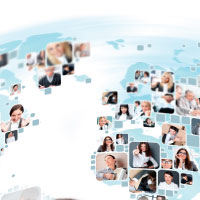 In the last month our lives got stuck to models. Especially to models of pandemic spread of viruses.
In the last month our lives got stuck to models. Especially to models of pandemic spread of viruses.
The principal idea of all these models is grouping into 4 categories: susceptible, exposed, infectious and removed.
Susceptible are all those who can get the virus. Exposed are all those who still have the virus, but are not infectious for others because of the incubation time of the disease. The critical group is the infectious – those who transfer the virus to other people. And in the end the divided group of the removed ones, combining the unlucky victims as well as the lucky healed persons.
These groups can be integrated by differential equations to predict further development of the model.
This is only possible by inserting parameters into the equation, for example the number of exposed and the time of incubation. The initial parameter setting will fundamentally steer the system.
The need for prediction lies in the exponentially spread of pandemic viruses. The fast duplication of quantity will affect new qualities especially the excessive demand of medical services. With outperforming a critical quantity of infected the growth is hardly to control.
Models can be a great help for decision under uncertainty, but it’s crucial to see that not the virus is in the center of the prediction but the pandemic. The virus has no legs, so pandemic spread is causal to human behavior and is caused by social aspects instead of clinic course of disease.
This is especially true for dynamics of behavior in different groups. Society isn’t homogenous and mean values about global groups won’t tell anything about the development in a society. Take for example a special social milieu with social behavior increasing infections with the virus. In this case the mean growth of infected towards the society is moderate, but in this special milieu quantity reached a critical value forcing different dynamics of behavior in other subsystems with feedback to the total system and environment.
Furthermore, people aren’t one-dimensional just like gas atoms. We are neither locked fundamentally to a single milieu or cluster, nor do we behave in a uniform defined way. Framing and a social logic of space plays a crucial role for communication and behavior. People react to pragmatic aspects of communication and environment by creating a new environment or cultural area. Without keeping this in mind, predictions from models can quickly shrink to seducing in the dark.
Modelling social complex adaptive systems should take fundamental aspects of social theory into the setting besides correlations. With this worldview on reality and scientific knowledge, models are some kind of metaphors and can’t be the logical answer to society – but the crucial question.
But most modelers behave just like trainers after a lost game, claiming that the players didn’t perform the match plan.